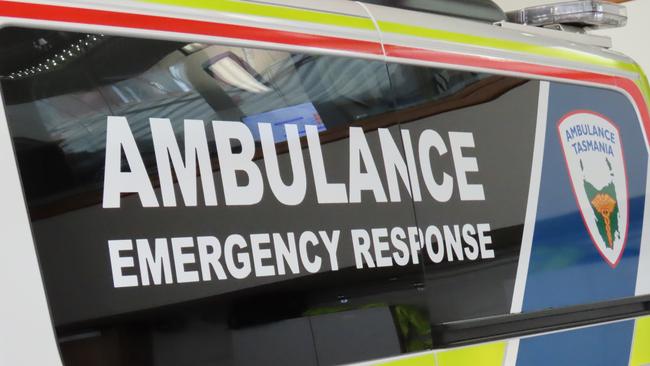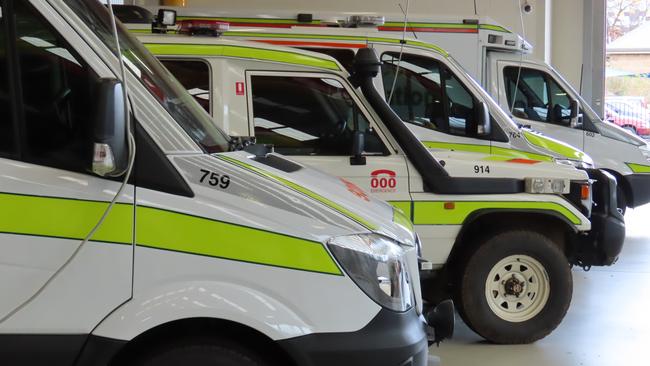Ambulance ramping getting worse in Tasmania amid nation crisis: AMA
A new report has revealed ramping is becoming worse in Tasmania and reflects national failure to meet performance targets. LATEST >>
Police & Courts
Don't miss out on the headlines from Police & Courts. Followed categories will be added to My News.
AMBULANCE ramping is becoming worse in Tasmania, reflecting a national failure to meet performance targets, the Australian Medical Association (AMA) says.
The AMA says there is no jurisdiction in the nation able to meet its own deadlines to transfer patients from ambulances into the emergency department.
Tasmania has a target to deliver 100 per cent of patients in 30 minutes.
It reported only 79.6 per cent were transferred in this timeframe in 2020-21. That result was 14.5 per cent worse than the year before.
“Tasmania’s patient transfer performance has been deteriorating year-on-year since at least 2015-16, where 92.1 per cent of patients were transferred within 15 minutes and 95.2 per cent were transferred within 30 minutes,” the report said.
“This represents a 26.2 per cent deterioration and 15.6 per cent deterioration in performance for the 15- and 30-minute targets respectively, compared to 2020-21.’’
It comes days after a coroner’s report finding that patient off-loading delays at the Royal Hobart Hospital contributed to a four-hour wait for a critically injured Howrah man.

AMA president Omar Khorshid said that in the past two years, there had been increased reports of ramping, people needing to be driven to emergency departments because of a lack of ambulances and people dying while waiting for an ambulance.
“Ambulance ramping outside hospitals – sometimes for hours – means not only are patients not receiving timely care, but paramedics can’t respond to new emergencies,” Dr Khorshid said.
In her findings published on Tuesday, Coroner Olivia McTaggart found a 77-year-old Howrah man died after waiting four hours and 15 minutes for an ambulance in September 2020, meaning he “had no chance of recovery”.
The coroner found that while she could not find the man would have been saved, the delay meant that he had no chance of recovery.
State Health Commander Kathrine Morgan-Wicks said the figures in the report did not paint a complete picture. “When results are adjusted to correspond with how other jurisdictions measure performance, Tasmania recorded one of the highest proportions of patients transferred from ambulance to hospital within 30 minutes,” she said.
“The Department of Health acknowledges that further improvement can be made and has already commenced a multi-year access and patient flow program across the state that will deliver projects to reduce access block and ramping delays at our major hospitals.”
‘No chance of recovery’: Man dies after prolonged ambulance wait – May 10
A HOWRAH man died after waiting four hours and 15 minutes for an ambulance, meaning he “had no chance of recovery”, a coroner has found.
The death a 77-year-old is the latest revelation of a death linked to delays by ambulances, in hospital waiting rooms, or amid Tasmania’s “ramping” crisis.
In her findings published Tuesday, Coroner Olivia McTaggart said the deceased had fallen in September 2020 while putting air into his tyres, hitting the back of his head.
Several hours later that evening, the deceased called for an ambulance using his personal alert – but the ambulance didn’t arrive until after midnight.
He was found on the floor near his reclining chair, “conscious and alert”, but died three days later.

In her findings published on Tuesday, Coroner Olivia McTaggart said an error was made by the Ambulance Tasmania officer triaging the call, who entered the deceased man’s case in the dispatch system as having occurred more – rather than fewer – than six hours earlier.
“This would have resulted in the case being allocated a higher response priority,” Ms McTaggart said.
The coroner said ambulance personnel phoned the deceased about two hours after his initial call, with no answer, but did not upgrade the priority of his case as it should have been.
Ms McTaggart also said there was a patient off-loading delay at Royal Hobart Hospital, contributing to a lack of ambulances available at the time.
She also said there were insufficient crews at the time of the call and a generally high ambulance caseload in the region.
The coroner said since man’s death, Ambulance Tasmania had implemented education and follow-up for staff on its medical priority dispatch system and had introduced a call-back procedure “specifying rules around patient follow-up and call-back in the event of delays in attendance”.

“Unfortunately, (the deceased) suffered a serious head injury, with extensive bleeding. Based upon the expert medical opinion in this case, I am not able to find that the sad outcome for (the deceased) would have been different if he had been transported to the hospital at an earlier time,” Ms McTaggart said.
“However, the delay meant that he had no chance of recovery.”
In April, the Mercury reported that an elderly man who waited nearly seven hours for an ambulance died by the time a crew arrived.
It followed several reports about seriously ill patients affected by the hospital’s “ramping” crisis, where paramedics were required to wait in ramped vehicles for sometimes hours at a time until they could be admitted.
Chief Executive of Ambulance Tasmania Joe Acker said the Department of Health acknowledged the “deeply distressing nature” of the case and following an internal review Ambulance Tasmania had implemented a number of changes.
“The Department is committed to continuous improvement and will carefully consider the Coroner’s report, noting no recommendations were made.” said Mr Acker.




